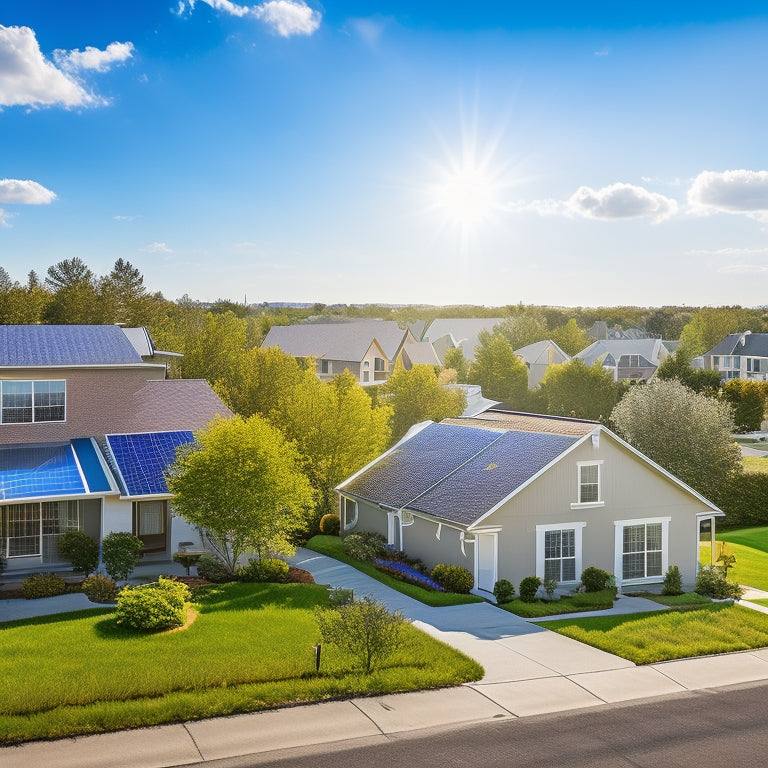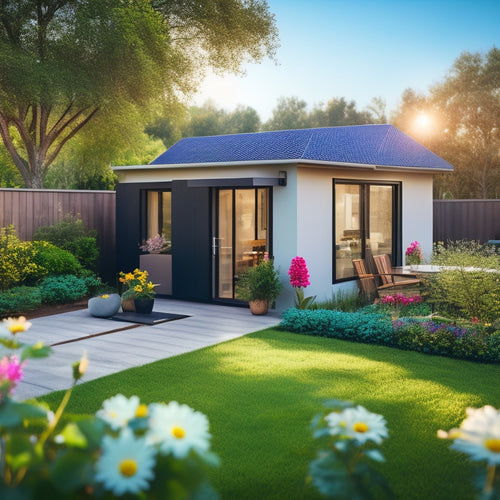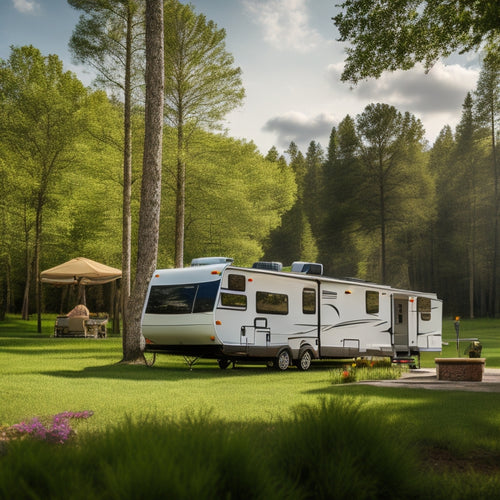
Residential Solar Panel System Costs Revealed
Share
You can anticipate paying between $15,000 and $30,000 for a residential solar panel system, with the overall cost breaking down into several key components, including panels, inverters, mounting hardware, and labor. The system's size and efficiency will impact the final cost, with larger systems requiring more equipment and installation complexity. Financing options and local incentives can help offset the cost. As you explore your options, you'll need to take into account factors like roof size and orientation, battery backup systems, and maintenance fees. There's more to uncover about the intricacies of residential solar panel system costs - and it's worth delving into further.
Key Takeaways
• The average cost of a residential solar panel system ranges from $15,000 to $30,000, including equipment and labor.
• Financing options like solar loans and leasing programs are available to help offset the upfront cost of the system.
• The cost of a solar panel system is affected by the system size, with larger systems requiring more equipment and resulting in higher costs.
• Higher-efficiency systems may have a higher upfront cost, but they can lead to greater long-term savings due to increased energy production.
• Additional costs, such as battery backup systems and monitoring and maintenance fees, can add $7,000 to $15,000 or more to the total system cost.
Average Cost of Installation
When contemplating a residential solar panel system, you'll want to know that the average cost of installation ranges from $15,000 to $30,000 for a typical single-family home. This cost includes the solar panels, inverters, mounting hardware, and installation labor. While this upfront cost may seem challenging, various financing options can help make solar energy more accessible. You can explore options like solar loans, power purchase agreements, or leasing programs to reduce the financial burden.
It's essential to take into account the installation timelines as well. The installation process typically takes around 2-5 days, depending on the complexity of the project. However, the entire process, from initial consultation to system activation, can take several weeks to a few months. This includes permitting, inspections, and utility approvals.
Understanding the average cost of installation and the associated timelines will help you plan and budget for your residential solar panel system. By exploring financing options and understanding the installation process, you can make an informed decision about investing in solar energy for your home.
System Size and Cost Correlation
When evaluating a solar panel system for your home, it's crucial to understand how system size impacts cost. A larger system doesn't always mean higher energy density, but it does mean more equipment and installation costs.
Here are some key factors to keep in mind when assessing system size and cost:
-
Larger systems require more equipment: More panels, inverters, and mounting hardware increase the upfront cost, but also provide more energy and potential cost savings.
-
Energy density affects system size: Systems with higher energy density require fewer panels to produce the same amount of energy, reducing costs.
-
System size impacts installation complexity: Larger systems require more complex installations, which can increase labor costs.
- Cost savings come with larger systems: While larger systems are more expensive upfront, they can provide greater cost savings over time through reduced energy bills.
Number of Panels and Pricing
As you explore the cost of a residential solar panel system, you'll find that the number of panels required has a substantial impact on the overall price. Factors like your energy usage, roof size, and local building codes influence the quantity of panels needed, which in turn affects the system's cost.
Panel Quantity Factors
Determining the required number of solar panels for your residential system involves calculating your home's energy needs and evaluating the available roof space, which greatly influences the overall system cost.
You'll need to take into account factors that impact the number of panels you'll need, including:
-
Panel spacing: Leaving adequate space between panels guarantees sufficient airflow and heat dissipation, which can affect energy output.
-
Energy output: The more energy you need, the more panels you'll require. Your energy output requirements will depend on your home's energy usage and the local solar irradiance.
-
Roof size and layout: The available roof space will determine the maximum number of panels you can install.
- Panel efficiency: More efficient panels can generate more energy per unit area, reducing the number of panels needed.
System Cost Breakdown
When evaluating your residential solar panel system, it's crucial to analyze the cost breakdown of individual components, including the panels themselves, inverters, mounting hardware, and installation labor.
The number of panels plays a significant role in determining the overall expense. You must assess the complexity of your system, as systems with more complexity require additional components, leading to higher costs. For instance, a system with a greater number of panels will necessitate more inverters, mounting hardware, and labor, which will raise the total cost.
To provide you with a clearer picture, here is a rough breakdown of the expenses involved: panels typically represent around 40-50% of the total cost, inverters 10-15%, mounting hardware 5-10%, and installation labor 20-30%.
It's important to note that these figures are approximate and actual costs may vary based on your specific system requirements. When developing financial forecasts, it's crucial to analyze these individual components and their associated expenses to obtain an accurate estimation of your system's total cost.
Effects of Efficiency on Cost
Your solar panel system's efficiency strongly impacts its cost, with higher-efficiency systems often resulting in higher upfront costs. This is because more efficient systems use advanced technology to maximize energy production, which increases their cost per watt. However, this higher upfront cost can lead to greater long-term energy savings.
Here are some key factors to bear in mind when evaluating the effects of efficiency on cost:
-
Higher efficiency means more power per hour of sunlight:
With higher-efficiency panels, you can generate more power in the same amount of time, resulting in greater energy savings over time. -
Higher cost per watt:
While more efficient panels are more expensive upfront, they can provide greater energy savings in the long run. -
Performance ratio is key:
A higher performance ratio indicates a more efficient system, which can lead to greater energy savings and a faster return on investment.
-
Efficiency affects system size and installation cost:
A more efficient system may require fewer panels and less installation materials, reducing overall costs.
Roof Size and Orientation Impact
When sizing up a residential solar panel system, you'll find that your roof's size and orientation play a significant role in determining how much energy you can harness from the sun. The ideal roof size and orientation will vary depending on your climate zone and local building codes.
For instance, in warmer climates, a south-facing roof with a slope between 15° to 40° is ideal, while in cooler climates, a steeper roof pitch may be more suitable.
Roof architecture, including features like solar windows, can also impact energy production. Shading patterns from nearby obstructions, such as trees or neighboring buildings, must be factored into the design. Obstruction analysis is important to optimize energy output.
Additionally, roof materials, ventilation systems, and building codes all influence the final system design. By carefully evaluating these factors, you can optimize your solar panel system's performance and maximize your energy savings.
A thorough assessment of your roof's size and orientation is essential to getting the most out of your solar investment.
Local Incentives and Rebates
Government agencies and local authorities offer various incentives and rebates to encourage homeowners to adopt solar energy, and you can greatly reduce your upfront costs by taking advantage of these programs.
As a homeowner investing in solar energy, you can benefit from local incentives and rebates that can meaningfully decrease the overall cost of your solar panel system.
Some of the local incentives and rebates you may be eligible for include:
-
State Tax Credits: Many states offer tax credits to homeowners who install solar panel systems, which can be claimed against your state tax liability.
-
Utility Discounts: Some utility companies offer discounted rates for homeowners who generate their own electricity through solar energy.
-
Local Rebate Programs: Municipalities and local governments may offer rebates to homeowners who install solar panel systems, which can be in the form of a one-time payment or a credit towards your property taxes.
- Property Tax Exemptions: Some states and local governments exempt solar panel systems from property taxes, which can help reduce your overall tax burden.
Battery Backup System Costs
When considering a residential solar panel system, you'll want to factor in the cost of a battery backup system, which can provide power during outages. The cost of this system will depend on the components you choose, including the type and quality of batteries, inverters, and other equipment.
You'll need to balance these system component costs with your desired backup power capacity, which will dictate how long your system can provide power during an outage.
System Component Costs
Your total system cost will increase by $7,000 to $15,000 or more, depending on the type and quality of battery backup systems you choose to integrate into your residential solar panel system. This significant cost variation is largely attributed to the component quality and material durability of the battery backup system.
Here are some key factors that influence the cost of your battery backup system:
-
Battery type and chemistry: Lithium-ion batteries are more expensive than lead-acid batteries, but they offer better performance and longer lifetimes.
-
Battery capacity and size: Larger batteries with higher capacities cost more, but they provide more backup power and longer autonomy.
-
Inverter and charger quality: High-efficiency inverters and chargers with advanced features, such as grid-tie functionality and monitoring capabilities, are more expensive.
- Certifications and compliance: Battery backup systems that meet specific certifications, such as UL 9540, may cost more due to the additional testing and compliance requirements.
When selecting a battery backup system, it's essential to balance component quality, material durability, and cost to ensure you get a reliable and efficient system that meets your power needs.
Backup Power Capacity
The backup power capacity of your battery backup system, typically measured in kilowatt-hours (kWh), directly impacts the overall cost, with higher capacities necessitating more expensive systems. As you consider your energy needs, you'll want to think about how much power you'll require during an outage. Do you want to power just the essentials, like lights and refrigeration, or do you want to maintain grid independence and keep your entire home running smoothly?
Your backup power capacity will also influence your emergency preparedness. If you live in an area prone to natural disasters or frequent outages, you may want to invest in a larger system to make sure you're prepared for extended periods without grid power. A larger system will, of course, come at a higher cost.
However, the peace of mind that comes with knowing you're prepared for any situation may be well worth the investment. By carefully considering your energy needs and emergency preparedness goals, you can determine the ideal backup power capacity for your system and budget.
Mounting and Racking System Costs
You'll need to budget around 10-15% of your total system cost for a mounting and racking system, which securely fastens your solar panels to your roof. This may seem like an important expense, but it's vital for guaranteeing the structural integrity of your solar panel system.
A well-designed mounting and racking system provides:
-
Ground clearance: allowing for easy cleaning and maintenance access
-
Structural integrity: ensuring your solar panels can withstand various environmental conditions
-
Adjustable tilt and angle: optimizing energy production and reducing shading
- Compliance with local building codes: avoiding potential issues with local authorities
A high-quality mounting and racking system won't only ensure your solar panels are securely fastened but also help maximize energy production. Be sure to factor this essential component into your overall system cost to ensure a safe and efficient solar panel installation.
Monitoring and Maintenance Fees
As you navigate the total cost of owning a residential solar panel system, factor in recurring monitoring and maintenance fees, which can range from $400 to $1,000 per year, depending on the scope of services and provider. These fees cover essential services that guarantee your system operates at peak performance and extends its lifespan.
You'll benefit from regular remote checks, which allow providers to detect and troubleshoot issues promptly, minimizing downtime and lost energy production. Scheduled inspections are also vital, as they enable technicians to identify and address potential problems before they become major issues.
Some providers may offer premium maintenance packages, including more frequent inspections, priority support, and performance guarantees. When evaluating monitoring and maintenance fees, consider the provider's reputation, response times, and the level of support offered.
Frequently Asked Questions
Can I Install Solar Panels on a Metal or Clay Tile Roof?
You can install solar panels on a metal or clay tile roof, but you'll need to make sure proper roof preparation to avoid tile damage, using specialized flashing and mounting systems designed for your specific roof type.
How Long Does It Take to Install a Residential Solar Panel System?
"Think you're ready to harness solar power? Buckle up, because the installation timeline can take anywhere from a few days to several weeks, depending on the complexity of the permit process and your roof's uniqueness."
What Happens to Solar Panels During a Blackout or Grid Outage?
When the grid goes dark, you're not left in the dark: your solar panels continue generating power, and with Energy Storage, you'll maintain Grid Security, ensuring a reliable supply of electricity during a blackout or grid outage.
Do Solar Panels Increase the Value of My Property?
Did you know that 80% of homebuyers consider energy efficiency a top priority? You'll be glad to know that installing solar panels can increase your property value by up to 17%, boosting your home equity and making your property appraisal shine.
Can I Expand My Solar Panel System in the Future if Needed?
You can easily expand your solar panel system in the future if needed, thanks to its scalable design, allowing for seamless future upgrades and ensuring your system remains efficient and effective.
Related Posts
-

Find Your Eco-Friendly Motorcycle for a Sustainable Ride
You're shifting gears towards a more sustainable ride, opting for an eco-friendly motorcycle that combines thrill wit...
-

Best Online Solar Panel Systems for Small Homes
When choosing the best online solar panel system for your small home, consider top-rated brands like SunPower, Panaso...
-

What Are the Best RV Battery Charging Systems?
You need a reliable RV battery charging system that meets your power requirements, guarantees efficient energy storag...


